Copper chelators for treating ocular inflammation
a technology of copper chelators and ocular inflammation, which is applied in the field of copper chelators for treating ocular inflammation, can solve the problems that copper chelating compounds containing sulfhydryl groups, such as d-penicillamine, may not be effective, and achieve the effect of inhibiting ocular inflammatory responses
- Summary
- Abstract
- Description
- Claims
- Application Information
AI Technical Summary
Benefits of technology
Problems solved by technology
Method used
Image
Examples
example 1
Inhibition of Copper-Catalyzed Generation of Hydroxyl Radicals by Copper Chelator TRIEN
[0027]In order to show that copper is the major catalyst in the auto-oxidation reaction and in the generation of free radicals a copper chelator was used to inhibit the generation of free radicals. The copper chelator used was TRIEN, which is used clinically for the treatment of Wilson's disease. The effect of TRIEN on the generation of .OH from cysteine autoxidation was tested by measuring the production of .OH with a CCA fluorescence assay. The reaction mixture included 1 mM, TRIEN, 100 μM cysteine, 0.2 μM Cu2+, 1 mM CCA, and PBS. The control contains all components except TRIEN. As shown in FIG. 1, the addition of TRIEN inhibited the generation of .OH from copper-catalyzed cysteine auto-oxidation.
example 2
Effect of Copper Chelators on the Inflammatory Reaction Following PDT and Photocoagulations
[0028]To determine the effect of copper chelators on the inflammatory reaction after PDT and photocoagulation, retinal thickness was measured following laser therapy.
[0029]Retinal Thickness (Edema) after Laser Therapy
[0030]A comparison was made of rat eyes following photocoagulation therapy, where the rats received either TRIEN, TETREN, D-PA or no copper chelator (control treated) prior to laser therapy. When the rat eyes were compared on the basis of retinal thickness, the eyes from control animals (saline injected) were greater than those of the TRIEN or TETREN groups as represented in FIG. 2. At twenty-four hours post photocoagulation treatment, the retinal thickness of eyes from control animals was 50% greater than that in normal retina, where no laser treatment and no copper chelator was given. The retinal thickness of eyes of TRIEN injected animals was 23% greater than that in normal ret...
example 3
Immunohistochemical Examinations after Laser Treatment
[0033]To determine if the tissue inflammation could be correlated with the immune response were stained with macrophage antibody (ED-1). TRIEN and TETREN inhibited the immunoresponse in ocular tissues following laser therapy. All experimental animals showed a similar sequence of immunohistochemical findings, which are summarized in FIG. 4. At twenty-four hours after laser treatment, the macrophage staining was clearly evident in eyes from control animals (saline injected). In eyes from TRIEN and TETREN treated animals showed fewer macrophages at the laser therapy sites. The number of ED-1 positive retina cells in TRIEN treated animals were approximately half that of the controls (saline injected). And similarly the number of ED-1 positive retina cells in TETREN treated animals were more than half that of control animals.
[0034]These results indicate that the copper chelators TRIEN or TETREN were effective in reducing immune respon...
PUM
| Property | Measurement | Unit |
|---|---|---|
| pH | aaaaa | aaaaa |
| wavelength | aaaaa | aaaaa |
| diameter | aaaaa | aaaaa |
Abstract
Description
Claims
Application Information
 Login to View More
Login to View More - R&D
- Intellectual Property
- Life Sciences
- Materials
- Tech Scout
- Unparalleled Data Quality
- Higher Quality Content
- 60% Fewer Hallucinations
Browse by: Latest US Patents, China's latest patents, Technical Efficacy Thesaurus, Application Domain, Technology Topic, Popular Technical Reports.
© 2025 PatSnap. All rights reserved.Legal|Privacy policy|Modern Slavery Act Transparency Statement|Sitemap|About US| Contact US: help@patsnap.com



